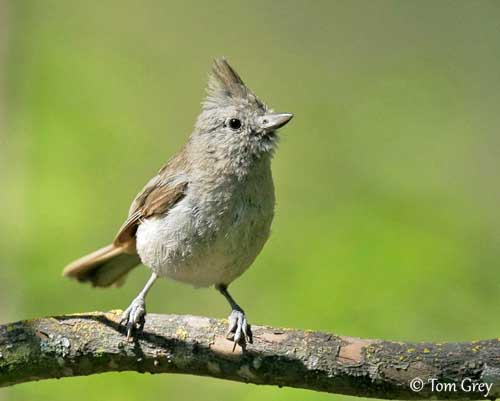
Fr: Mésange unicolore
All: Schlichtmeise
Esp: cabonero sencillo
Ital: Cincetta delle querce
Nd: Grijze Mees
Sd: Kalifornisk gråmes
Photographers:
Tom Grey
Tom Grey's Bird Pictures
Tom Merigan
Tom Merigan’s Photo Galleries
Text by Nicole Bouglouan
Sources:
HANDBOOK OF THE BIRDS OF THE WORLD Vol 12 by Josep del Hoyo-Andrew Elliott-David Christie - Lynx Edicions - ISBN: 8496553423
BIRDS OF THE GREAT BASIN – by Fred A. Ryser - Univ of Nevada Pr -ISBN: 0874170796
FIELD GUIDE TO THE BIRDS OF NORTH AMERICA - National Geographic Society - ISBN: 0792274512
BirdLife International (BirdLife International)
All About Birds (Cornell Lab of Ornithology)
South Dakota Birds and Birding (Terry L. Sohl)
What Bird-The ultimate Bird Guide (Mitchell Waite)
Wikipedia, the free encyclopaedia
Oak Titmouse
Baeolophus inornatus
Passeriforme Order – Paridae Family
INTRODUCTION:
This pretty bird belongs to the genus Baeolophus which contains five species found in the Nearctic. All titmice are distinctly crested, even in juvenile plumage. They form the group of the New World crested tits, whereas the genus Lophophanes includes the Old World crested tits which are smaller than the North American species.
DESCRIPTION OF THE BIRD:
Biometrics:
Length: 15-16 cm
Weight: 12-19 g
The Oak Titmouse adult male of nominate race has grey-brown upperparts, including crown, crest and upperwing-coverts. The back is tinged warmer brown, whereas the rump is buffish-brown or slightly paler. The greater coverts show dark grey centres. The flight feathers are dark grey, finely edged grey-brown. The tail is dark grey-brown with paler fringes.
On the underparts, chin, throat and centre of upper breast are pale grey. Rest of underparts are pale buffish-grey, with pale brown lower flanks and undertail-coverts.

On the head, the crest is conspicuous. Forehead, lores, cheeks and ear-coverts are grey, or finely mottled darker. The neck sides are white.
The bill is dark grey. The eyes are dark brown. Legs and feet are dull bluish-grey.
Both sexes are similar.
The juvenile resembles adult, but it has paler tips to greater coverts and the rectrices are more pointed than in adults.
SUBSPECIES AND RANGE:
We can find four subspecies:
B.i. inornatus (here described) is found in SW USA, from SW Oregon, S to SW and SC California.
B.i. affabilis occurs in SW California and extreme NW Mexico (N Baja California). This one resembles nominate but has larger bill, less grey upperparts, duller underparts with washed grey-brown flanks. The birds from SW California are slightly browner.
B.i. mohavensis is found in SE California (Little San Bernardino Mts). This race is slightly paler or greyer than previous, with washed pale grey flanks.
B.i. cineraceus occurs in W Mexico (S Baja California). It is similar to nominate, with slightly smaller bill and shorter tail, with greyer upperparts and paler underparts.
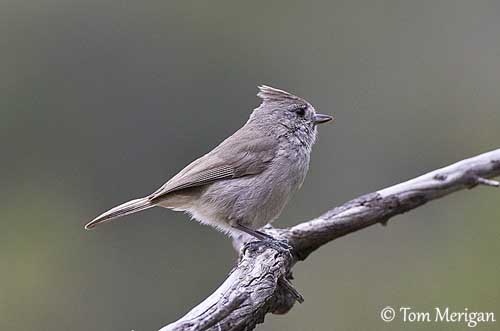
HABITAT:
The Oak Titmouse frequents the dry evergreen woodlands with mainly oaks (Quercus), but also pines (Pinus), juniper (Juniperus) or California laurel of genus Umbellularia. But this species is also present in chaparral, alders (Alnus) and well-wooded suburban areas.
It can be occasionally found higher (up to 1304-2285 metres) in warmer climate such as that of S California. In Mexico, (Baja California), it is found between 500 and 2400 metres of elevation, due to hot temperatures below 500 metres in desert.
Elsewhere in its range, the Oak Titmouse is present in extensive oak woodlands.
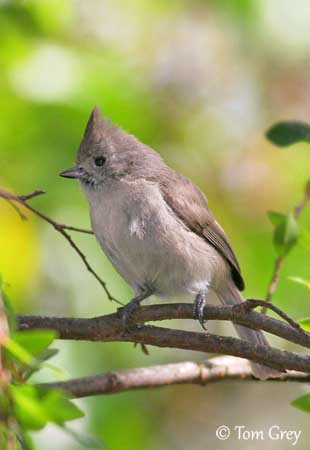
CALLS AND SONGS: SOUNDS BY XENO-CANTO
The Oak Titmouse male gives two basic songs, both in a clear whistle, a repeated series of “pli” or “tui” notes. We can also hear some “peter peter peter” with higher-pitched first syllable, a less common “sweet sweet sweet” rising in inflection and sometimes uttered very slowly “swe-it swe-it swe-it”.
Calls include soft “sip”, “sit-sit” and other variations, a more scolding “tzer-zer-zer-zer”, and a thin, high-pitched “see-see-see”.
In territorial defence, both sexes give loud calls or songs, usually in combination with wing vibrations.
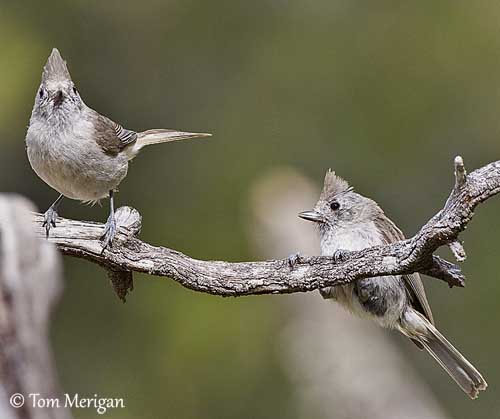
BEHAVIOUR IN THE WILD:
The Oak Titmouse feeds mainly on small invertebrates and larvae, but it also takes plant matter such as acorns, leaf buds, catkins and berries.
It is rarely seen outside the canopy foliage, and it forages in middle to upper level of trees. It gleans among the foliage and strips away short pieces of bark to reach the hidden insects. It may forage on the ground too, but only in areas with thin ground cover. The prey is usually carried to a perch for better viewing. While foraging, the Oak Titmouse frequently looks around and is constantly on its guard.
They frequently forage in mixed-species groups, but this species is usually seen alone, in pairs or in family groups.
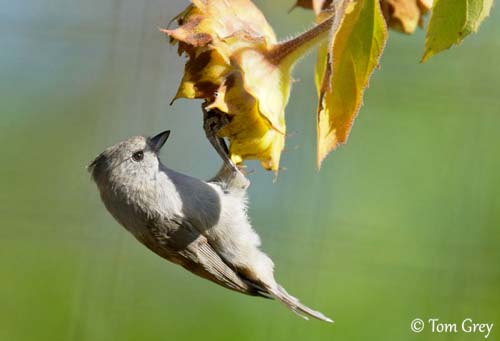
The Oak Titmouse is monogamous and has long-term pair-bonds, usually for life. The pair defends the territory all year round, but more strongly in spring, and after breeding too, in order to avoid incursion from wandering juveniles. Both mates defend the area where they remain all the year.
The territorial defence is mainly by vocal behaviour such as scolds, calls or songs, in combination with wing vibrations and erect crest. They roost in cavities or in dense foliage.
The pair-bonds are formed in the first year and are usually for life. Courtship feeding by male to female is often observed. As they mate for life, the courtship displays are reduced.
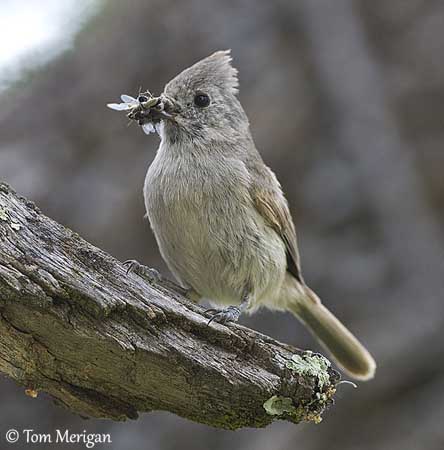
The Oak Titmouse is resident in its range. Only the young birds perform short-distance movements around the breeding range.
It performs weak fluttering flight with shallow wingbeats between branches and trees. It flies with shallow undulating motion.
REPRODUCTION OF THIS SPECIES:
The Oak Titmouse produces a single brood between late March and mid-July.
The female selects the nest-site and builds the nest in a cavity, often a hole in tree or an abandoned woodpecker hole, at about 1-3 metres above the ground. The hole can be adapted by excavating in rotten wood.
The nest-site is often reused, but nest box or artificial sites can be used too.
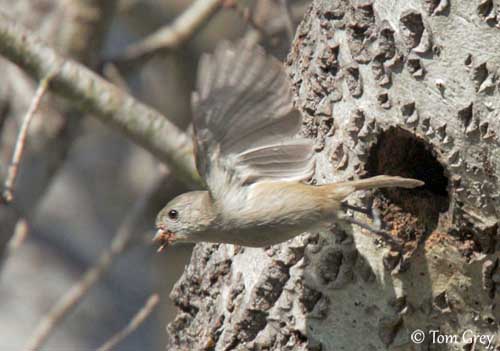
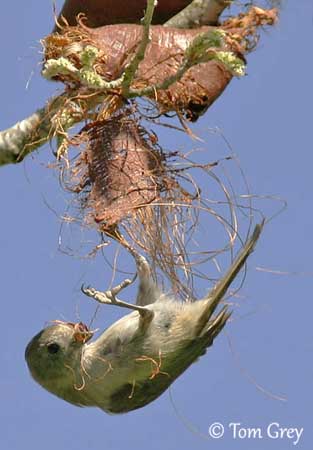
The nest is made with several materials such as grass, moss, plant fibres, bark strips, animal fur, feathers, wool, straw, string, snakeskin, rootlets…
The female lays 6-9 whitish eggs with darker spots. She incubates during 16 days, and she is fed by the male during this period. Both parents feed the chicks, but the male brings most food. The young fledge between 16 and 21 days after hatching. They are still fed by adults for up to 28 days after fledging.
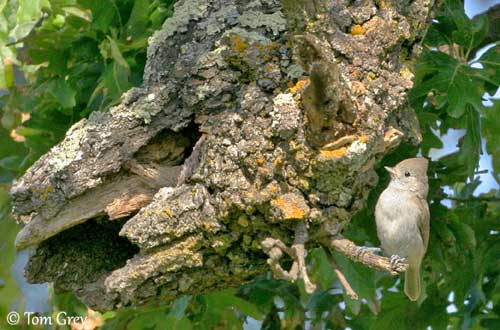
PROTECTION / THREATS / STATUS:
The Oak Titmouse is common to fairly common throughout the range, and mainly in oak woodlands in California.
Their populations appear stable in suitable habitat. However, human developments have increased pressures on oak forests, such as clearing for agriculture, and urban and suburban developments.
The Oak Titmouse is killed by several predators such as mammals, snakes and larger birds, often Strigidae, Corvidae and Accipitridae. But this small bird mobs predators, often with other small ones, joining their forces against the danger.